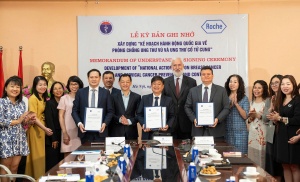 |
This message was underscored at a VIR seminar in Hanoi on September 5 that explored innovation in the healthcare and pharmaceutical sector.
Dao Thuy Ha, deputy general director of Traphaco JSC, a pharmaceutical manufacturer combining traditional medicine with modern practices, said, “Traphaco has shifted from specialising in Oriental medicines to developing high-quality modern pharmaceuticals. To achieve this, we are investing heavily in research and development (R&D) and have received technology transfers from Daewoong, one of South Korea’s leading pharmaceutical firms.”
Thanks to this strategy, Traphaco can rapidly develop bio-equivalent versions of original drugs for chronic conditions such as cardiovascular disease, diabetes, and hypertension. This enables Vietnamese patients to access high-quality medicines at affordable prices, especially for long-term treatments that require stable, daily use.
“We are also accelerating digital transformation. By leveraging AI, the company has exploited data to improve efficiency, implemented data analysis to create sales and marking campaigns, and gained customer insights to develop sales centres and logistics centres to reduce human-related processes. The AI integration creates a seamless and cost-efficient operation,” added Ha.
The company also applies AI to analyse and verify input medicinal materials, detect counterfeits, and assess each component (roots, branches, stems, leaves, etc.) with precise ratios to quickly evaluate product quality. This application of AI enables the company to ensure consistent and reliable product standards.
Le Xuan Tan, general director of private healthcare group TNH Hospital Group, said, “TNH now operates three facilities with 800 hospital beds, and we are moving forward with plans to build a smart hospital. Key components are already in place, including electronic medical records, a Hospital Information System, a Laboratory Information System, and a Picture Archiving and Communication System.”
Thanks to these smart systems, test results are processed and sent back to the initial point of care, saving patients time and travel. TNH also operates an imaging diagnosis centre connected to all hospitals in its network. For CT scans and MRIs, TNH strives to deliver results within two hours to reduce waiting time.
“We plan to integrate AI across our operations, from staff management to patient care. During consultations, AI will capture doctor–patient interactions and combine them with test results to generate rapid diagnostic suggestions. This will provide doctors with valuable references and support faster, more accurate treatment decisions,” added Tan.
According to Bui Le Ha, chief digital transformation officer of the Medlatec General Hospital, “Digital transformation has helped reduce patient waiting times to just 30 per cent. X-ray services now take only 30 minutes, other services at most one hour, and test results are returned within the same day.”
However, Ha also pointed out some challenges to fast-track digital transformation in the medical and pharmaceutical sector. “The lack of specific guidelines forces businesses to proceed cautiously, working according to their own understanding while constantly fearing mistakes. Some practices may not be entirely wrong but still not fully correct, which could lead to additional costs for adjustments later on.”
“For example, we talk about using AI in healthcare, but there are no legal regulations clearly defining to what extent AI can be applied, to what level it is accepted, or how it aligns with the law. Similarly, while the law requires data interoperability, there are still no guidelines on common standards for how such interoperability should be implemented,” he said.
There is a pressing need for more policies that foster innovation and creativity. Such policies would encourage businesses to invest in research and development while creating a favourable environment for startups, scientists, and entrepreneurs to bring new ideas to life. By encouraging innovation, Vietnam can strengthen its competitiveness, accelerate sustainable growth, and better integrate into the global value chain.
Ha from Traphaco cited figures showing that 65 per cent of medicines used in Vietnam are still imported, while only 35 per cent are produced domestically. Pharmaceutical companies are aware of their responsibility to gradually increase the domestic share to meet the government’s targets and aim for double-digit average growth through 2030.
“Our top priority is developing bio-equivalent drugs. We have many R&D plans underway, but limited evaluation resources continue to slow progress,” Ha said.
The national strategy for the development of the pharmaceutical industry through 2030, with a vision to 2045, outlines requirements to establish R&D centres to evaluate bioequivalence and bioavailability studies. There are also incentives and new advantages for enterprises to set up such research facilities.
“With these regulations in place, I hope it will create better conditions for companies to develop new medicines more efficiently and at lower cost, ultimately benefiting patients,” she added.
Ha hopes that companies will receive the government’s support to connect with domestic scientists and leverage scientific research to turn it into practical products for the market. This would maximise Vietnam’s resources, support the development of new therapeutic products, and foster innovation in creating better medicines for the country.
In fact, the development of Vietnam’s pharmaceutical and healthcare sector will open opportunities for exports while helping reduce the significant outflow of foreign currency from Vietnamese patients seeking treatment abroad, which can reach $3–4 billion annually.
Tan from TNH said, “Private hospitals must both be self-reliant and strengthen cooperation with central-level hospitals. For example, inviting top experts to handle the most complex cases. Private hospitals have advantages in medical equipment and service quality. We can attract patients to stay and receive treatment in localities, instead of having to travel to big cities or go abroad.”
“In fact, some central hospitals already receive foreign patients for treatment, which is an extremely positive signal. We hope to contribute, even in a small way, to delivering better healthcare for both domestic and international patients, particularly those who visit Vietnam as tourists,” added Tan.
 |
Portfolio overhauls illustrate Vietnam’s potential
Vietnam’s healthcare and pharmaceutical market has become heated as investors step up the restructuring of their investment portfolios. |
 |
New partnership targets improved cancer care for Vietnamese women
Vietnam is ramping up efforts to tackle breast and cervical cancer – two major health challenges that continue to weigh heavily on women and society. |
 |
Moving towards modern and sustainable pharma industry
Vietnam’s pharmaceutical industry strategy for the rest of this decade and beyond is of particular importance, demonstrating the government’s determination to build a modern and developing industry, better meeting people’s healthcare needs as well as regional and international integration requirements. |





